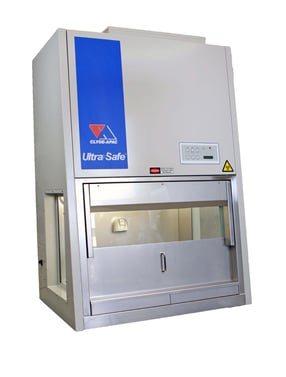
These specialised cabinets provide a safe and controlled workspace for handling pathogenic materials, ensuring the containment of potentially harmful microorganisms. The aim of this blog article is to explore the key features, classifications, applications, and benefits of Class 2 microbiology safety cabinets, shedding light on their critical role in promoting safe and effective research in the field of microbiology.
Thermoline can supply the AES Class 2 Ultrasafe range on cabinets.
Understanding Class 2 Microbiology Safety Cabinets
Class 2 microbiology safety cabinets are designed to provide personnel, product, and environmental protection. They are built to adhere to the guidelines set by international standards, including NSF/ANSI 49, EN 12469, and BMBL (Biosafety in Microbiological and Biomedical Laboratories). These cabinets are equipped with high-efficiency particulate air (HEPA) filters, which ensure that the air inside the cabinet is continuously filtered and free from harmful contaminants. Class 2 BSCs offer a recirculating airflow pattern that provides protection to both the operator and the samples being handled. Please note that there are particular Australian standards for this type of cabinet.
Key Features of Class 2 Microbiology Safety Cabinets
1. Airflow and Containment: Class 2 BSCs feature a laminar airflow, which directs the air away from the operator's breathing zone, preventing exposure to potentially hazardous microorganisms. The cabinet is designed to maintain a negative pressure relative to the surrounding environment, ensuring that any leaks are inward, protecting the external environment.
2. HEPA Filters: High-efficiency particulate air (HEPA) filters used in Class 2 BSCs remove particles down to 0.3 micrometres in size, guaranteeing that the air inside the cabinet is clean and free from microorganisms.
3. Exhaust System: Class 2 safety cabinets are equipped with an exhaust system to remove contaminated air from the workspace, ensuring that no harmful substances escape into the laboratory.
4. UV Light: Many Class 2 BSCs are equipped with ultraviolet (UV) lights to provide an additional layer of protection by disinfecting the interior surfaces of the cabinet.
5. Work Surface: The work surface of Class 2 BSCs is made from stainless steel, which is easy to clean and resistant to most chemical corrosion, providing a safe and durable workspace.
Classifications of Class 2 Microbiology Safety Cabinets
Class 2 BSCs are categorised into three types based on their airflow patterns:
1. Type A1: Type A1 cabinets have a minimum inward airflow velocity of 75 linear feet per minute (lfpm) and protect the operator and the environment. These cabinets do not protect the sample being handled.
2. Type A2: Type A2 cabinets protect the operator and the sample being handled. They have a minimum inward airflow velocity of 100 lfpm and a total exhaust airflow velocity of 70 % of the inlet velocity.
3. Type B2: Type B2 cabinets protect the operator, environment, and the sample. These cabinets have a minimum inward airflow velocity of 100 lfpm and a total exhaust airflow velocity of 100 % of the inlet velocity.
Applications of Class 2 Microbiology Safety Cabinets
1. Microbiological Research: Class 2 BSCs are used in microbiology laboratories for various research applications, such as cell culture, isolation of pathogenic microorganisms, and handling infectious materials.
2. Clinical and Diagnostic Laboratories: These cabinets are employed in clinical and diagnostic laboratories for the safe handling of patient specimens and infectious agents.
3. Pharmaceutical and Biotechnology Industries: Class 2 BSCs play a critical role in pharmaceutical and biotechnology research and production, where handling of biological materials is essential.
4. Vaccine Development: In vaccine development, Class 2 BSCs are used to handle live attenuated viruses and other infectious agents safely.
5. Forensic Laboratories: Class 2 BSCs are utilised in forensic laboratories for the safe handling of biological evidence during investigations.
Benefits of Using Class 2 Microbiology Safety Cabinets
1. Personnel Safety: The primary benefit of Class 2 BSCs is the protection they provide to laboratory personnel against exposure to hazardous microorganisms and agents.
2. Environmental Protection: Class 2 BSCs maintain a negative pressure inside the cabinet, preventing any harmful contaminants from escaping into the laboratory environment.
3. Sample Integrity: These cabinets help maintain the integrity and viability of biological samples and cultures during manipulation and experimentation.
4. Contamination Control: Class 2 BSCs significantly reduce the risk of cross-contamination between different samples and experiments.
5. Regulatory Compliance: Using Class 2 microbiology safety cabinets ensures compliance with biosafety regulations and guidelines, providing peace of mind for laboratory managers and personnel.
Class 2 microbiology safety cabinets are essential tools for researchers and laboratories working with hazardous microorganisms and biological agents. Their airflow pattern, HEPA filters, exhaust systems, and UV light features ensure a safe and controlled environment for handling infectious materials. By providing protection to both laboratory personnel and the surrounding environment, Class 2 BSCs play a critical role in promoting safe and effective research in the field of microbiology. As technology advances and biosafety standards evolve, Class 2 microbiology safety cabinets will continue to be instrumental in advancing scientific knowledge and protecting public health.
Our Thermoline sales team are happy to answer any enquiries that you may have.






